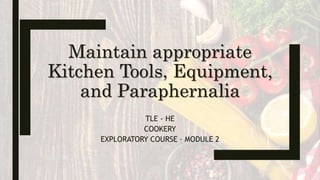Cookery Module 2 Maintain appropriate kitchen tools
- 1. Maintain appropriate Kitchen Tools, Equipment, and Paraphernalia TLE - HE COOKERY EXPLORATORY COURSE – MODULE 2
- 2. â– Cleaning and sanitizing procedures must be part of the standard operating procedures that make up your food safety program. Improperly cleaned and sanitized surfaces allow harmful microorganisms to be transferred from one food to other foods.
- 3. Cleaning â– is the process of removing food and other types of soil from a surface, such as a dish, glass, or cutting board. â– is done with a cleaning agent that removes food, soil, or other substances.
- 4. Four Categories of Cleaning Agent
- 5. 1. Detergents â– Use detergents to routinely wash tableware, surfaces, and equipment. Detergents can penetrate soil quickly and soften it. â– Examples include dishwashing detergent and automatic dishwasher detergents.
- 6. 2. Solvent cleaners â– Use periodically on surfaces where grease has burned on. â– Solvent cleaners are often called degreasers.
- 7. 3. Acid cleaners â– Use periodically on mineral deposits and other soils that detergents cannot remove. These cleaners are often used to remove scale in ware washing machines and steam tables.
- 8. 4. Abrasive cleaners â– Use these cleaners to remove heavy accumulations of soil that are difficult to remove with detergents. Some abrasive cleaners also disinfect. Clean food contact surfaces that are used to prepare potentially hazardous foods as needed throughout the day but no less than every four hours. If they are not properly cleaned, food that comes into contact with these surfaces could become contaminated.








